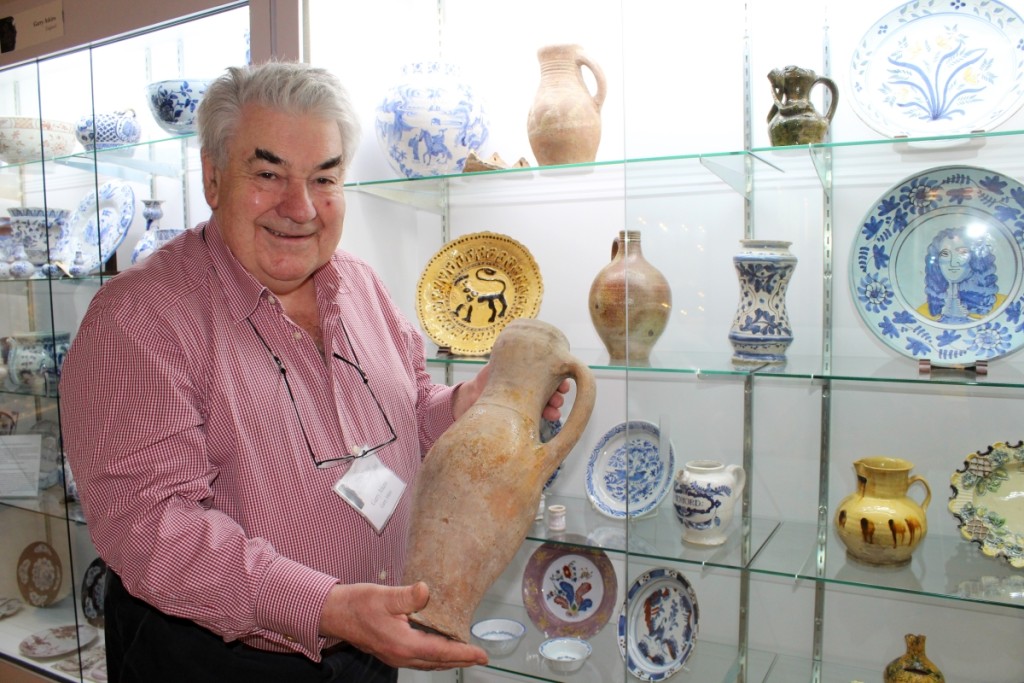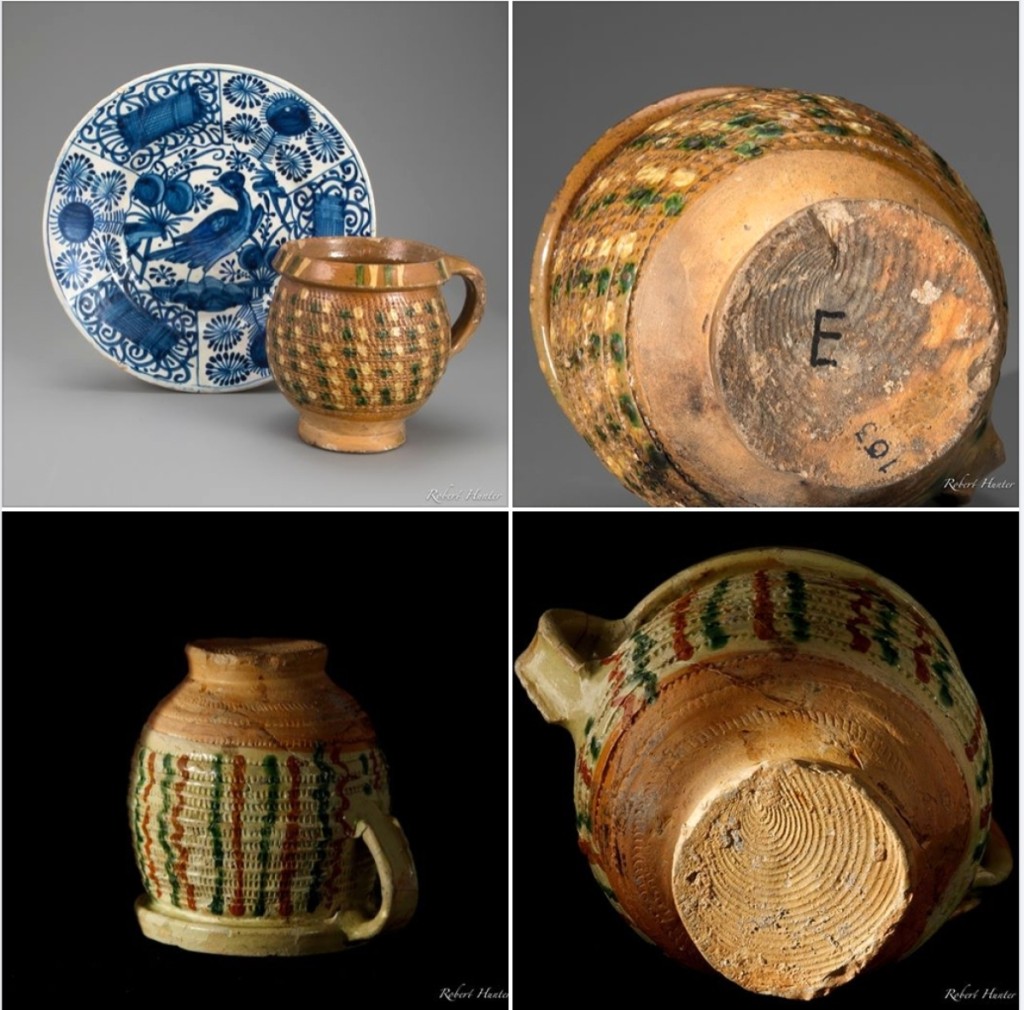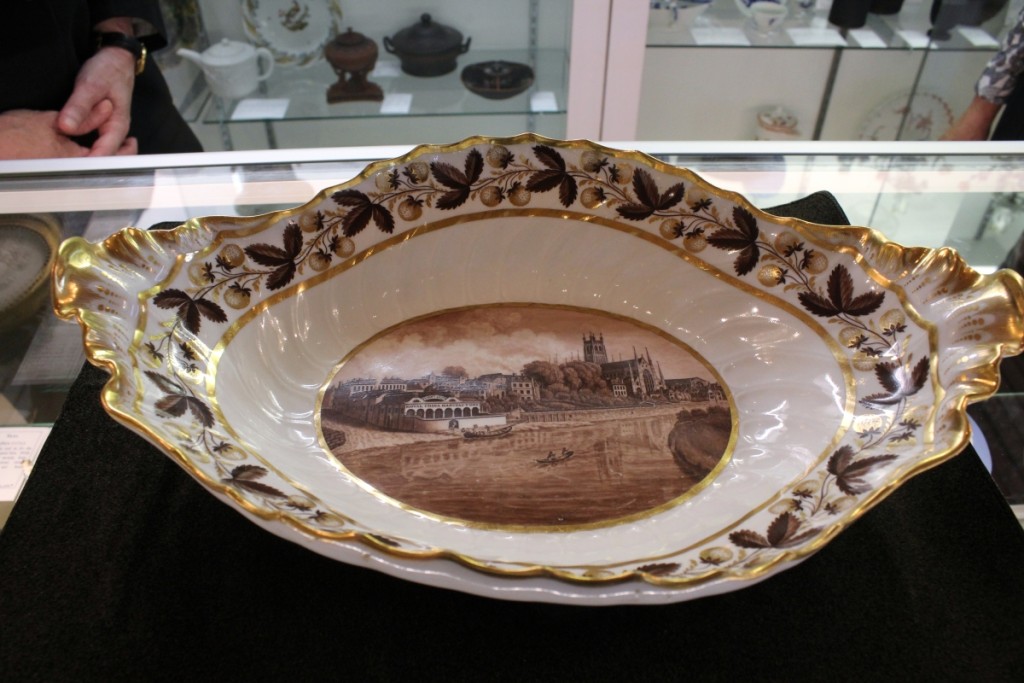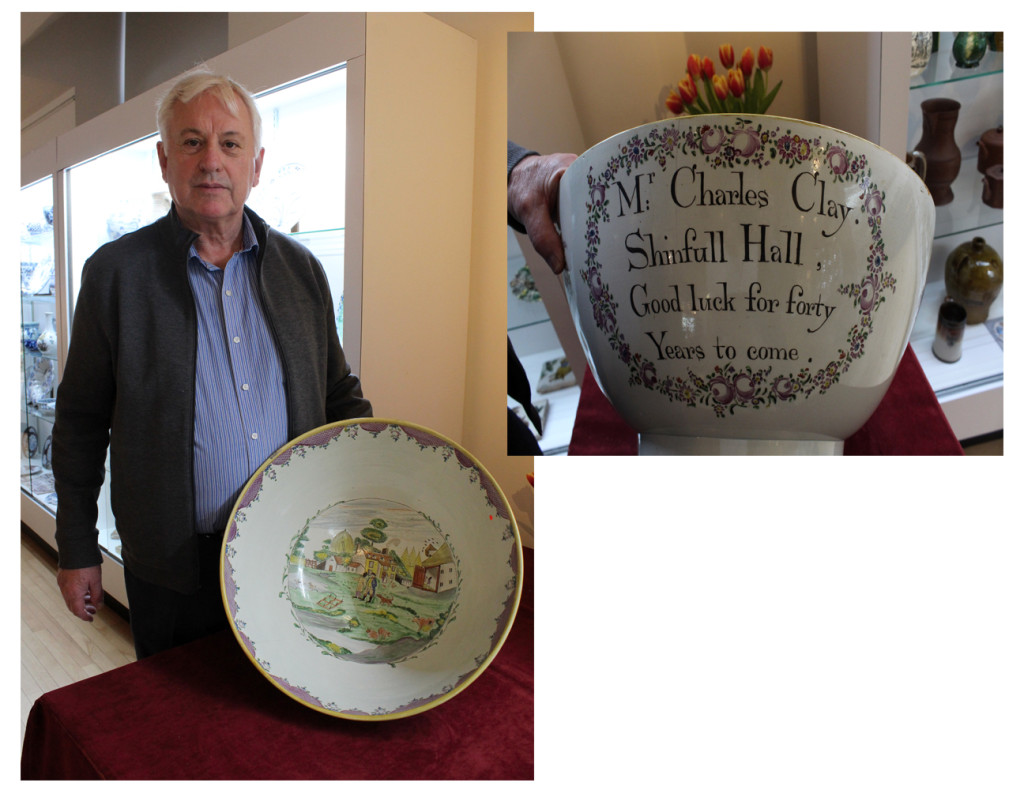
Garry Atkins with a Thirteenth Century tall vase. “It’s amazing that it’s so old but has no damage,” said the dealer as he carefully removed it from the shelf. It sold to Rob Hunter.
NEW YORK CITY – With just a few additions, the New York Antique Ceramics Fair, January 23-26, at the Bohemian National Hall, maintained its boutique character as a small and focused exhibition and sales event.
The show used to be known as the New York Ceramics and Glass Fair, and it was revived in 2019 by a small band of dealers who, stunned by the sudden announcement in June 2018 that show managers Liz Lees and Meg Wendy had decided not to continue the show, coalesced into a plucky vanguard aiming to present a smaller edition of the New York Antiques Week staple. Ideally placed within a short walk or cab ride from the Art, Design and Antiques Show at Wallace Hall, the Winter Show, Sotheby’s and Christie’s and the many events and exhibitions that have Manhattan in their thrall, the fair offered yet one more compelling incentive – admission was complimentary.
Just as last year, the smaller show was set up on the third floor of Bohemian National Hall rather than the fourth and fifth floors as before. There were no lectures or special exhibitions, just a focused gathering of 11 specialists (three more than 2019’s show) with some great material.
Opening with a well-attended private preview on January 22, it was, by most accounts, a successful four days, and it was not just the dealers who were delighted – this from ceramics scholar and dealer Rob Hunter, who found several treasures to add to his own and Chipstone’s collection: “The Ceramics Fair was fantastic! I could have spent days going through all the materials. Good energy and great objects from a more diverse range of dealers! Congratulations to them!”
Chipstone purchased a large Staffordshire presentation punch bowl from Martyn Edgell, a showstopper if there ever was one, measuring 19 inches across, dated circa 1800 and illustrated inside with a farm scene.

Ceramics scholar and dealer Rob Hunter showcased some of the treasures he picked up at the show on his Facebook page, including the rare 1630s-40s Portuguese small dish, upper left, and rare Weser ware handled jar with rouletted slip decoration. “The Ceramics Fair was fantastic! I could have spent days going through all the materials,” he said.
“I bought several things from Martyn and Sheila – they had an amazing assortment – for personal inventory, including a wonderful Eighteenth Century creamware teapot with the saying ‘Solitude is My Choice,’ perfect for the introverted teapot collector,” Hunter continued. “I’m still considering the fantastic King William III Westerwald portrait mug, circa 1690-1700.
Hunter said he also purchased a number of things from early English pottery specialist Garry Atkins – “A wonderful early Eighteenth Century Staffordshire slipware cradle – ex-Longridge Collection – for a Midwestern collector/client and several rare Eighteenth Century mugs that had come from the personal collection of the late Jonathan Horne.”
That wasn’t all, however. Hunter, for his own inventory, purchased from Atkins what he believes was among the most important ceramic objects at the fair – a Twelfth or Thirteenth Century British baluster jug in what Atkins himself described as “amazingly wonderful condition.” Such rare medieval jugs are icons of early British ceramic history and can be found in the collections of the V&A and the British Museums.
Returning exhibitors to the fair included Antiques LPC van Geenen with specialty in Dutch delftware. Here, Hunter said he was able to fill his shopping bag with several things, including a rare 1630s Portuguese majolica dish and a circa 1610. Weser Ware (northern Germany) slipware, “both with important parallels to archaeological examples from Seventeenth Century Virginia archaeological sites; these will end up with an important American collection based on archaeological parallels,” said Hunter.
Also returning was Lee Bradshaw with the Australian firm Etruria Antiques Gallery. “Numbers were up, and there was much interest, particularly in the Wedgwood, which sold well,” said Bradshaw. “It was also interesting to note the number of younger people, some with knowledge and others there out of interest and just beginning on the path to collecting. There was also a number of modern potters, interested in learning the technical aspects of the earlier wares.”

This large dish, called a comport, Worcester, circa 1800, is illustrated with a view of the Flight & Barr Porcelain Factory. Although a transfer print, the hand painted platter is rare, according to Etruria Antiques Gallery, Melbourne, Australia.
Bradshaw added that he hopes there will be more dealers next year, expanding into one of the other rooms on the same floor. “Overall, I think the quality was improved on last year and a comment I heard a number of times was that it was good to see the fair growing at such an early stage in its new life.”
Robert Walker, Polka Dot Antiques, Waccabuc, N.Y., also noted an influx of more youthful attendees. “One noticeable addition to the visitors was the number of millennials that were looking to furnish their apartments with antique furniture and accessories, such as ceramic table lamps, vases and bowls. Something their grandmother might have had. Talking to several such visitors, part of the concern was to reuse or repurpose antique furniture rather than buy something new that meant more trees or chemicals had to be used to make such new furniture.”
In his showcase, Walker had the most interest in a Weildon-type guglet, 1745-55, which was displayed in a contemporary and rare tooled leather traveling case with brass hooks and iron hinges. Equally ogled was a Liverpool creamware jug inscribed “Makin Mill” below a colored transfer print of a mill and “Success to the Cotton Manufactory” below initials H, R&M.
“Sales were across the board from early salt-glazed stoneware, including a very rare large Admiral Vernon ‘Portobello’ mug; another salt-glazed molded panels mug; a creamware mug with an amusing colored transfer print signed by John Aynsley, Lane End, ‘The Pig & the Pot a Tale’; a rare early Staffordshire Lion and Unicorn spill vase and a pair of late 1960s Wedgwood black basalt ‘Brutalist’ vases,” said Walker.
His collection of eight Charles Vyse figures of “The London Gypsy Street Sellers” also drew much interest.
As befits a scholarly area like antique ceramics, not all of the fair was about commerce. It also saw the launch of Circa1775, an endeavor by first-time exhibitor Harwood “Woody” Johnson that shared original research in the form of three stories using Wedgwood pottery as a character in each story. “The first story was about Wedgwood vases that Lord Macartney took as gifts for the Xianlong emperor of China in 1793,” said the dealer. “The second story was about the birth of Australia told in a single object. The third story was about the birth of neoclassicism, also told in a single object, supplemented by the books that spread knowledge of the classical world in the 1760s-70s. We showed just nine pieces of Wedgwood, each one, if I may say, extraordinary. Prices ranged from $2,600 to $110,000.”

Martyn Edgell with large Staffordshire bowl, a clear showstopper, which was purchased by Chipstone. A presentation piece, it measures 19 inches across, dated circa 1800 and is illustrated inside with a farm scene. “The show gets better year by year and having it in those rooms is so much better than the hall before,” said Edgell. “I sold my mocha ware particularly well and sold antislavery ceramics to three separate museums in the United States, roll on 2021.”
Business goals were all met successfully, said Johnson. “The first goal was to launch the business – to make it well-known rapidly in the well-publicized and exciting ambiance of the fair. The second goal was to find if the storytelling approach created interest among people who are not typically collectors of Wedgwood. The third goal was to begin relationships via email with people interested in the stories, not only with collectors, but with museum professionals, academics, students, potters and people just interested in history. Selling was not a key goal, but it looks like we will sell enough to cover the costs of the fair.
The fair’s other two new dealers were Mark and Marjorie Allen, Laconia, N.H., best known for English and Dutch delftware of the Seventeenth and Eighteenth Centuries, and Samuel Herrup who, since 1971, has been dealing in American redware and stoneware. Allen said he had a number of sales to museums, plus much follow-up communication, providing additional details to potential customers. “I was blown away by the quality of the show,” he said, adding, “liked it better than a number of other shows I have done.”
For additional information, www.nyceramicsfair.com.

























